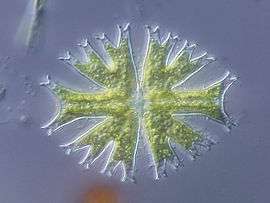Desmidiales
| Desmids | |
|---|---|
 | |
| Micrasterias furcata | |
| Scientific classification | |
| (unranked): | Archaeplastida |
| Kingdom: | Plantae |
| Division: | Charophyta |
| Class: | Zygnematophyceae |
| Order: | Desmidiales |
| Families | |
Desmids (Gr. desmos, bond or chain) are an order (Desmidiales) in the Charophyta, a division of green algae that forms a sister group to the land plants (Embryophyta).[1]
The desmids are often treated as members of the Zygnematales, as family Desmidiaceae.[2][3] The Desmidiales comprise around 40 genera and 5,000[4] to 6,000[5] species, found mostly but not exclusively in fresh water. Many species may be found in the fissures between patches of sphagnum moss in marshes. With a pH level of approximately 4.0, sphagnum peat provides the ideal environment for this flora.
Morphology
The structure of these algae is unicellular, while the cell is sometimes divided into two symmetrical compartments separated by a narrow bridge or isthmus, wherein the spherical nucleus is located. Each semi-cell houses a large, often folded chloroplast for photosynthesizing. One or more pyrenoids can be found. These form carbohydrates for energy storage. The cell-wall, of two halves (termed semicells), which, in a few species of Closterium and Penium, are of more than one piece, has two distinct layers, the inner composed mainly of cellulose, the outer is stronger and thicker, often furnished with spines, granules, warts et cetera. It is made up of a base of cellulose impregnated with other substances including iron compounds, which are especially prominent in some species of Closterium and Penium and is not soluble in an ammoniacal solution of copper oxide.
Desmids assume a variety of highly symmetrical and generally attractive shapes, among those elongated, star-shaped and rotund configurations, which provide the basis for their classification.[6] The largest among them may be visible to the unaided eye.[7]
Desmidiales lack flagella. Desmids commonly reproduce by asexual fission, however, in adverse conditions, Desmidiales may reproduce sexually, through a process of conjugation,[8] which are also found among the Zygnematales. These two groups are closely related, and comprise the class Zygnematophyceae. They resemble the algae genus Spirogyra as some of them are filamentous, such as the species Desmidium swartzii. However, these filaments are arranged in a helix pattern.[6]
Desmids possess characteristic crystals of Barium sulphate at either end of the cell[9] which exhibit a continuous Brownian type motion.
Many desmids also secrete translucent, gelatinous mucilage from pores in the cell wall that acts a protecting agent. These pores are either, as in Micrasterias, uniformly distributed across the cell-wall but always appear to be absent in the region of the isthmus, or, in highly ornamented forms, as many genera of Cosmarium, grouped symmetrically around the bases of the spines, warts and so on with which the cell is provided.
In the inner layer of the wall the pore is a simple canal, but in the outer, except in Closterium, the canal is surrounded by a specially differentiated cylindrical zone, not composed of cellulose, through which the canal passes. This is termed the pore-organ. The canals are no doubt in all cases occupied by threads of mucilage in process of excretion. At the inner surface of the wall they terminate in lens- or button-shaped swellings, while from the outer end of the pore-organ there sometimes arise delicate radiating or club-shaped masses of mucilage through which the canal passes and which appear to be more or less permanent in character. In most cases, however, these are absent or only represented by small perforated buttons.
Classification
Classification of the families and genera in the Desmidiales:[10]
|
|
The family Mesotaeniaceae were formerly included in the Desmidiales,[11] but analysis of cell wall structure and DNA sequences show that they are more closely related to the Zygnemataceae, and so are now placed together with that family in the order Zygnematales.
References
- ↑ Gontcharov AA, Marin BA, Melkonian MA (January 2003). "Molecular phylogeny of conjugating green algae (Zygnemophyceae, Streptophyta) inferred from SSU rDNA sequence comparisons". J. Mol. Evol. 56 (1): 89–104. doi:10.1007/s00239-002-2383-4. PMID 12569426.
- ↑ Kanetsuna, Y. (2002). "New and interesting desmids (Zygnematales, Chlorophyceae) collected from Asia". Phycological Research. 50 (2): 101–113. doi:10.1046/j.1440-1835.2002.00263.x.
- ↑ "World Register of Marine Species". Retrieved 18 September 2014.
- ↑ Van den Hoek, C., D. G. Mann, & H. M. Jahns, 1995. Algae:An Introduction to Phycology, page 468. (Cambridge: Cambridge University Press). ISBN 0-521-30419-9
- ↑ Brook, Alan J., 1981. The Biology of Desmids, page 1. (Berkeley: University of California Press). ISBN 0-520-04281-6
- 1 2 http://www.microscopy-uk.org.uk/mag/indexmag.html?http://www.microscopy-uk.org.uk/mag/wimsmall/algdr.html
- ↑ http://www.desmids.com/
- ↑ Kapraun DF (April 2007). "Nuclear DNA content estimates in green algal lineages: chlorophyta and streptophyta". Ann. Bot. 99 (4): 677–701. doi:10.1093/aob/mcl294. PMC 2802934
 . PMID 17272304.
. PMID 17272304. - ↑ Proceedings of the Royal Society -Biological Minerals Formed from Strontium and Barium Sulphates. II. Crystallography and Control of Mineral Morphology in Desmids
- ↑ Guiry, M. D.; Guiry, G. M. (2016). "AlgaeBase". National University of Ireland. Retrieved 2016-09-18.
- ↑ http://www.ucmp.berkeley.edu/greenalgae/charophyta/desmidiales.html
Further reading
- Survey of Clare Island 1990 - 2005, noting the Desmidiales recorded. Ed. Guiry, M.D., John, D.M., Rindi, F. and McCarthy, T.K. 2007. New Survey of Clare Island. Volume 6: The Freshwater and Terrestrial Algae. Royal Irish Academy. ISBN 978-1-904890-31-7
External links
| Wikispecies has information related to: Desmidiales |